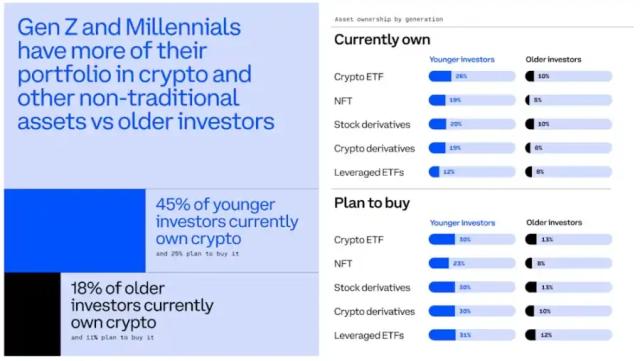Author: SuperEx
Compiled by: Blockchain Plain Language

Recently, the global market was shocked by the violent fluctuations in the US stock market. After the "peer tariff" news triggered a market crash, the White House announced a 90-day tariff suspension for certain countries, and the market quickly reversed and soared.
The Dow Jones Industrial Average surged over 2,900 points, rising 7.87%, marking the largest single-day gain since March 25, 2020. The S&P 500 rose 9.52%, the largest increase since October 29, 2008, while the Nasdaq index skyrocketed 12.16%, recording its second-largest single-day gain in history.
The "Seven Giants" tech stocks surged across the board, with their total market value increasing by $1.85 trillion in just a few hours.
"The US stock market is fluctuating like an Altcoin, and the world has become a massive pump and dump game."
This rhythm seems familiar - it's exactly the kind of violent price fluctuations we often see in the Altcoin market. Many market analysts couldn't help but exclaim:
However, the surprise from the United States did not stop there. The March CPI data was far below expectations: the year-on-year increase was only 2.4%, lower than market predictions, and even decreased by 0.1% month-on-month. The core CPI was equally disappointing, reaching a four-year low. The unadjusted core CPI year-on-year increase in March was 2.8%, declining for the second consecutive month, reaching the lowest level since March 2021, lower than the market's expected 3.0%.
These two sets of data not only surprised the market but also prompted investors to reassess the Federal Reserve's policy prospects. The market responded quickly:
Spot gold initially rose $6, then fell back;
The US dollar index dropped short-term by 20 points;
The pound sterling's intraday gain against the US dollar expanded to 1.00%.
Faced with such data, many market analysts now believe that a Fed rate cut in June is almost a certainty.
Harriet Torry, an economist at The Wall Street Journal, pointed out that under normal circumstances, a slowdown in year-on-year CPI growth would be considered good news.
This is naturally good news for the crypto market. With the Federal Reserve's benchmark interest rate falling, the crypto market may usher in a new round of value reassessment.
Relative Pricing Effect of Low Risk-Free Interest Rates
The US 10-year Treasury yield has dropped from the 2023 high of 4.8% to 4.28% (with a recent low of 4.18%, followed by a rebound of 10 basis points). The decline in traditional fixed-income asset returns is driving capital towards high-risk assets. Taking BTC as an example, its correlation with Treasury yields was as low as -0.73 in 2023. During the rate-cutting cycle, the opportunity cost of holding crypto assets significantly decreases, thereby enhancing their attractiveness. According to Goldman Sachs' model, each 25 basis point rate cut could increase BTC's market value by 6-8%.
Strengthening the "Digital Gold" Narrative
BTC's 90-day correlation with gold rose from 0.12 in 2023 to 0.35, reaching 0.68 during the Silicon Valley Bank crisis. When rate cuts and recession risks rise simultaneously, the hedging value of crypto assets may be re-evaluated. A Grayscale report indicates that for every 1% decrease in real interest rates, BTC's valuation baseline could increase by 15%.
Liquidity Injection from Rate Cuts
Historically, Federal Reserve rate-cutting cycles are often accompanied by widespread asset price increases. As liquidity loosens and capital costs decrease, investors' interest in risk assets increases - this is especially evident in the crypto market.
As high-volatility, high-risk tools, crypto assets are extremely sensitive to liquidity changes. When the Federal Reserve releases monetary easing signals, idle capital tends to chase higher returns, and crypto assets with high return potential quickly become the focus.
Economic Logic of Deflationary Tokens
Against the backdrop of expected legal tender depreciation, the scarcity premium of fixed-supply cryptocurrencies becomes increasingly prominent. This built-in deflationary characteristic increases anti-inflationary attractiveness during rate-cutting cycles.
Catalyst for Institutional Adoption
Rate Cuts Amplify the "Asset Shortage" Phenomenon
Lower interest rates reduce returns in traditional financial markets (such as bonds, money market funds), creating pressure for institutional reallocation. Long-term investors like insurance companies, pension funds, and family offices may redirect some capital towards growth-oriented emerging markets.
As ETF, custody, and audit regulatory infrastructures steadily mature, crypto assets become increasingly viable for compliant investment. In the context of low returns in traditional markets, institutions might incorporate BTC and Ethereum into diversified investment portfolios.
Crypto ETFs Synchronized with Rate-Cutting Cycles
By the end of 2024, the US approved multiple spot BTC ETF listings, a key moment for institutional funds to publicly enter the crypto market. If rate cuts synchronize with the ETF boom, the dual momentum of institutional inflows and macro liquidity expansion could further amplify the crypto market's upside potential.
Revival of On-Chain Activity in Crypto Ecosystem
DeFi Market Recovery
During the rate hike cycle, DeFi platforms struggled to compete with low-risk US Treasury returns, leading to a decline in Total Value Locked (TVL). As risk-free returns decrease, DeFi returns become attractive again, drawing capital back.
Leading protocols like Compound, Aave, and Lido have shown signs of TVL recovery. With on-chain lending rates stabilizing and stablecoin interest rate spreads expanding, capital efficiency improves - enhancing the DeFi ecosystem's liquidity.
NFT and GameFi Markets Regain Attention
Rate cuts release capital, reigniting user enthusiasm for high-volatility, high-engagement assets like NFTs and GameFi Tokens. Historically, NFT market activity typically lags behind BTC's rise and erupts in the second stage of major bull markets. The Federal Reserve's rate cut might open new upside spaces for these application-layer assets.
Summary
In conclusion, the Federal Reserve's rate cut establishes a macro foundation for a new crypto market upward cycle. From liquidity injection, capital reallocation to institutional entry, on-chain activity, and financing environment - rate cuts provide systematic tailwinds for the crypto industry.
As the Federal Reserve opens the liquidity gates, crypto assets are evolving from marginal speculative assets to mainstream macro allocation tools. This transformation is driven by traditional financial giants and technological breakthroughs, accompanied by market deep reshuffling and value reconstruction.
Of course, the market won't transform overnight. Regulatory transparency, technological infrastructure, and security challenges still need resolution. But under the dual engines of "monetary easing + asset innovation", the crypto market might welcome a new structural rise in the coming year. For investors and builders, understanding policy cycles and market rhythms will be key to navigating bull and bear markets.
Article link: https://www.hellobtc.com/kp/du/04/5743.html
Source: https://superex.medium.com/fed-rate-cut-in-june-all-but-certain-d10f3f2c218e







